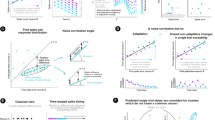Abstract
THE frequency of action potentials in a nerve fibre has long been known to be a function of the input intensity. Fluctuations in frequency when the stimulus is held constant have often been considered merely as unwanted ‘noise’ limiting the accuracy of the experimental results. However, these fluctuations may also limit the amount of information which can be transmitted down a nerve fibre and so are of interest per se. In a receptor or an isolated axon, these fluctuations may result from the basic processes of action potential initiation and are of interest in this context. If the variability had the same basis in different cells (for example, resistive noise), one would expect that it would be smaller, the larger the cell or axon, and this is often the case1. However, one of us (P. B. C. M.) noticed that the discharge initiated from single secondary endings of muscle spindles of the cat seemed to be considerably more regular than that from the primary endings, though these latter have the larger afferent nerve fibres2; later this was also found to have been noticed by others3,4.
This is a preview of subscription content, access via your institution
Access options
Subscribe to this journal
Receive 51 print issues and online access
$199.00 per year
only $3.90 per issue
Buy this article
- Purchase on Springer Link
- Instant access to full article PDF
Prices may be subject to local taxes which are calculated during checkout
Similar content being viewed by others
References
Verveen, A., Acta Morphologica Neerlando-Scandinavica, 5, 79 (1962).
Matthews, P. B. C., Physiol. Rev., 44, 219 (1964).
Eldred, E., and Tokizane, T., Amer. J. Physiol., 183, 612 (1955).
Hongo, T. (personal communication).
Ten Hoopen, M., and Verveen, A. A., in Nerve, Brain and Memory Models, edit. by Wiener, N., and Schade, J. P. (Elsevier, Amsterdam, 1963).
Stein, R. B., Biophysic. J., 5, 173 (1965).
Harvey, R. J., and Matthews, P. B. C., J. Physiol., 157, 370 (1961).
Matthews, P. B. C., J. Physiol., 169, 58P (1963).
Stein, R. B., J. Physiol. (1965).
Verveen, A. A., and Derksen, H. E., Kybernetik, 2, 152 (1965).
Katz, B., J. Physiol., 111, 248 (1950).
Author information
Authors and Affiliations
Rights and permissions
About this article
Cite this article
STEIN, R., MATTHEWS, P. Differences in Variability of Discharge Frequency between Primary and Secondary Muscle Spindle Afferent Endings of the Cat. Nature 208, 1217–1218 (1965). https://doi.org/10.1038/2081217a0
Issue Date:
DOI: https://doi.org/10.1038/2081217a0
This article is cited by
-
Regularity of muscle spindle receptor discharges at a different muscle length
Neuroscience and Behavioral Physiology (1984)
-
Characteristics of the sensory discharge of the muscle spindle in Xenopus laevis
Kybernetik (1974)
-
A second order mechanical model of muscle spindle primary endings
Kybernetik (1970)
-
A mechanical model of the secondary endings of mammalian muscle spindles
Kybernetik (1970)
-
A computer simulated model of a second order sensory neurone
Kybernetik (1969)
Comments
By submitting a comment you agree to abide by our Terms and Community Guidelines. If you find something abusive or that does not comply with our terms or guidelines please flag it as inappropriate.



